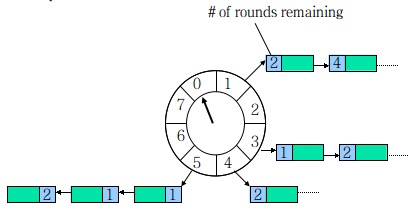HashWheelTimer功能是添加一个任务,指定在一段时间后执行。只执行一次,不可定时循环执行。
优点:
添加和删除的时间复杂度都是O(1)。添加的时候是直接添加到一个队列中。删除的时候并不是直接移除,而是给这个timeout设置一个cancel的标志位。
缺点:
- 不能定时重复执行定时任务
- 单线程执行,如果任务执行时间长会影响后面的任务执行
- 不适合创建那些时间跨度大的,应为只触发一次,会一直保存在时间轮的bucket中,时间过长会导致链表容易过长,且占用内存。

一. 数据模型
主要有两个数据结构,一个是构成时间轮的结构的HashedWheelBucket,一个是构成时间轮的每个格子中数据的HashedWheelTimeout。
1.1 HashedWheelTimeout
bucket中的每一个定时任务的封装,形成一个链表。每个定时任务中还有一个round属性,表示还要转多少轮才轮到它。 timeout中保存的属性:
- long类型的deadline,表示的是距离startTime的时间长度
- remainingRounds,剩余的的转动的轮数,其实上面的deadline一项就足够确定定时任务的执行时间的了。
1.2 HashedWheelBucket
时间轮中每一个格子的实例,在HashWheelTimer中保存的是HashedWheelBucket数组。数组的下标代表当前格子的跨度id。
1.3 时间轮
时间轮中保存的状态有:
- startTime, 时间轮的启动时间,用来计算差值确定具体的执行时间点
- tick,当前时间轮走过了多少个格子
- tickDuration,每一个格子的时间跨度是多长
二. 线程模型
内部有一个线程负责像时钟的指针一样,不断地转着。
这个内部线程的执行逻辑:
- 第三方线程拿到HashWheel实例,然后通过addTimeout(Timetask task)添加定时任务到一个临时queue中
- HashWheel内部线程worker循环执行,从queue拿出来这个定时任务,并且添加到bucket中
- 内部线程轮询线程执行
2.1 添加与删除定时任务
1
2
3
4
5
6
7
8
9
10
import java.util.concurrent.TimeUnit;
public class a {
public static void main(String[] args) {
HashWheelTimer timer = new HashWheelTimer();//默认时间轮是100毫秒一格,512格
TimeOut t = timer.newTimeout(timer, 10, TimeUnit.SECONDS);//添加一个十秒钟后执行的定时任务
t.cancel();//删除一个定时任务
}
}
2.2 时间轮执行主逻辑
1
2
3
4
5
6
7
8
9
10
11
12
13
14
15
16
17
18
19
20
21
22
23
24
25
26
27
28
29
30
31
32
33
34
35
36
37
38
39
40
41
42
43
44
45
46
47
48
49
50
51
52
53
54
55
56
57
58
59
60
61
62
63
64
65
66
67
68
69
70
71
72
73
74
75
76
77
78
79
80
81
82
83
84
85
86
87
88
89
90
91
92
93
94
95
96
private final class Worker implements Runnable {
private final Set<Timeout> unprocessedTimeouts = new HashSet<Timeout>();
private long tick;
@Override
public void run() {
// Initialize the startTime.
startTime = System.nanoTime();
if (startTime == 0) {
// We use 0 as an indicator for the uninitialized value here, so make sure it's not 0 when initialized.
startTime = 1;
}
// Notify the other threads waiting for the initialization at start().
startTimeInitialized.countDown();
do {
final long deadline = waitForNextTick();//休眠直到到下一个格子,返回醒来后的格子时间与时间轮开始时间的时间差
if (deadline > 0) {
int idx = (int) (tick & mask);//求余, 相当于 当前格子数 / 时间轮、定位出当前的格子数处于时间轮的哪个位置
processCancelledTasks();//处理被取消掉的任务
HashedWheelBucket bucket = wheel[idx];//取出对应的时间轮上的定时任务联表
transferTimeoutsToBuckets();//将定时任务队列中的任务添加到时间轮中
bucket.expireTimeouts(deadline);
tick++;
}
} while (WORKER_STATE_UPDATER.get(HashedWheelTimer.this) == WORKER_STATE_STARTED);
// Fill the unprocessedTimeouts so we can return them from stop() method.
for (HashedWheelBucket bucket : wheel) {
bucket.clearTimeouts(unprocessedTimeouts);
}
for (; ; ) {
HashedWheelTimeout timeout = timeouts.poll();
if (timeout == null) {
break;
}
if (!timeout.isCancelled()) {
unprocessedTimeouts.add(timeout);
}
}
processCancelledTasks();
}
private void transferTimeoutsToBuckets() {
// transfer only max. 100000 timeouts per tick to prevent a thread to stale the workerThread when it just
// adds new timeouts in a loop.
for (int i = 0; i < 100000; i++) {
HashedWheelTimeout timeout = timeouts.poll();
if (timeout == null) {
// all processed
break;
}
if (timeout.state() == HashedWheelTimeout.ST_CANCELLED) {
// Was cancelled in the meantime.
continue;
}
long calculated = timeout.deadline / tickDuration;//从时间轮开始转动到现在一共要走多少个格子才会触发这个timeout任务
timeout.remainingRounds = (calculated - tick) / wheel.length;//设置这个定时任务从当前开始还要走多少轮,tick表示时间轮转动到现在已经走了多少个格子了
//假如我原本是要走187个格子到达执行,但是现在已经到了190个格子了,那就立即把这个定时任务放到当前这个190的格子进行触发
final long ticks = Math.max(calculated, tick); // Ensure we don't schedule for past.
int stopIndex = (int) (ticks & mask);//求余,定位这个定时任务在队列中的位置
HashedWheelBucket bucket = wheel[stopIndex];
bucket.addTimeout(timeout);
}
}
public void expireTimeouts(long deadline) {
HashedWheelTimeout timeout = head;
// process all timeouts
while (timeout != null) {//处理这个bucket上的所有定时任务
HashedWheelTimeout next = timeout.next;
if (timeout.remainingRounds <= 0) {//轮数已经为0,就是到达自己的这一轮了
next = remove(timeout);
if (timeout.deadline <= deadline) {//这里为什么不判断 deadline-timeout.deadline<tickDurtion呢?这样能严格判断这个定时任务是出于这个格子中的。这里实际是考虑到前面的,过了自己执行格子的任务,能够马上执行
timeout.expire();//执行这个定时任务
} else {
// The timeout was placed into a wrong slot. This should never happen.
throw new IllegalStateException(String.format(
"timeout.deadline (%d) > deadline (%d)", timeout.deadline, deadline));
}
} else if (timeout.isCancelled()) {
next = remove(timeout);//任务取消了移除
} else {
timeout.remainingRounds --;//还没有到任务的轮数
}
timeout = next;
}
}
}
三. ScheduledExecutorService与HashedWheelTimer的对比?
ScheduledExecutorService保存任务的时候维护的是一个堆,需要频繁对任务进行添加或者修改的时候,需要频繁修改堆结构导致性能下降。 HashedWheelTimer则不受任务量的限制,也就是定时任务的增删改是很快的,不会额外占用投递线程的时间。它唯一的缺点是,有一个内部线程,在没有定时任务 的时候也会空转占用一定的CPU资源。